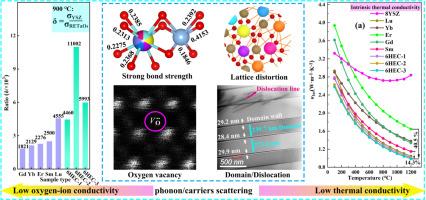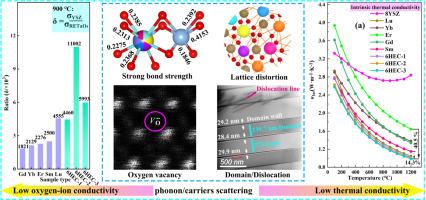Unveiling the mechanisms of ultra-low thermal and oxygen-ion conductivity in entropy-stabilized ferroelastic rare-earth tantalates
IF 8.3
1区 材料科学
Q1 MATERIALS SCIENCE, MULTIDISCIPLINARY
引用次数: 0
Abstract
Most current thermal and environmental barrier coating materials, even with high relative densities, exhibit high oxygen-ion conductivity, which accelerates the oxidation of the substrate and ultimately results in coating failure. Herein, high-entropy rare-earth tantalates ((6RE1/6)TaO4) are presented with lattice distortion that causes local disruption of the ordered stacking of oxygen-ions and cations, thereby resulting in reduced oxygen-ion and thermal conductivities. The oxygen-ion conductivity of (6RE1/6)TaO4 decreased by three to five orders of magnitude compared with that of 8YSZ and was further decreased by the high-entropy effect compared with that of single-RE RETaO4 from 600 to 900 ℃, which is the result of strong bond strength, severe lattice distortion, high oxygen vacancy clusters and a high concentration of immobile vacancies. Furthermore, the intrinsic thermal conductivity of (6RE1/6)TaO4 is 14.3∼40.5 % less than single-RE RETaO4 and ∼65.3 % lower than that of 8YSZ at 1200 °C. It also presents lower intrinsic thermal conductivity across the temperature range of 100 to 1200 °C. This is the result of scattering by Umklapp processes, oxygen vacancies, lattice distortions, ferroelastic domains and dislocations. Entropy-stabilized (6RE1/6)TaO4 also has excellent thermal stability and mechanical properties, thereby making it a promising thermal and environmental barrier coating material.


揭示熵稳定铁弹性稀土钽酸盐的超低热导率和氧离子导率机制
目前大多数隔热和环境阻隔涂层材料,即使具有较高的相对密度,也表现出较高的氧离子传导性,这会加速基底的氧化,最终导致涂层失效。这里介绍的高熵稀土钽酸盐((6RE1/6)TaO4)具有晶格畸变,会导致氧离子和阳离子的有序堆叠发生局部破坏,从而降低氧离子和热导率。与 8YSZ 相比,(6RE1/6)TaO4 的氧离子电导率降低了 3 至 5 个数量级,与 600 至 900 ℃ 的单RE RETaO4 相比,高熵效应进一步降低了其氧离子电导率,这是强结合强度、严重晶格畸变、高氧空位簇和高浓度不动空位的结果。此外,在 1200 ℃ 时,(6RE1/6)TaO4 的本征热导率比单RE RETaO4 低 14.3∼40.5%,比 8YSZ 低 65.3%。在 100 至 1200°C 的温度范围内,它的本征热导率也较低。这是由 Umklapp 过程、氧空位、晶格畸变、铁弹性域和位错散射造成的。熵稳定的(6RE1/6)TaO4 还具有出色的热稳定性和机械性能,因此是一种很有前途的隔热和环境屏障涂层材料。
本文章由计算机程序翻译,如有差异,请以英文原文为准。
求助全文
约1分钟内获得全文
求助全文
来源期刊

Acta Materialia
工程技术-材料科学:综合
CiteScore
16.10
自引率
8.50%
发文量
801
审稿时长
53 days
期刊介绍:
Acta Materialia serves as a platform for publishing full-length, original papers and commissioned overviews that contribute to a profound understanding of the correlation between the processing, structure, and properties of inorganic materials. The journal seeks papers with high impact potential or those that significantly propel the field forward. The scope includes the atomic and molecular arrangements, chemical and electronic structures, and microstructure of materials, focusing on their mechanical or functional behavior across all length scales, including nanostructures.
 求助内容:
求助内容: 应助结果提醒方式:
应助结果提醒方式:


